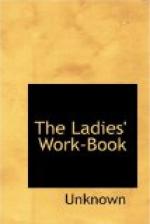There will now be 208 stitches, work on two rounds of scarlet, increasing to 240, and then join on the band. This is done by holding the top of the band and the edge of the round together, and working one round, taking up the chain of both. Work on the cord with black wool and white silk, two stitches of each alternately; draw in the end of twine. Take care in placing the two parts of the cap together, to make that part which begins every round at the same place in both, as a small defect in the pattern is inevitable, and must be covered by the tassel. Draw the string of the tassel through the centre of the crown, and fasten it in its place. The cap may be lined with scarlet sarsenet.
* * * * *
CROCHET EDGINGS AND INSERTIONS.
The whole of these edgings and insertions are intended to be worked either with or without beads. If to be worked with beads, 1 chain stitch must be reckoned in the foundation, for every square, and the ground must be perfectly solid, with the pattern in beads. If to be worked in square crochet, 3 chains must be allowed for every square. In the scallops the ends of the thread must be neatly run in after they are done. Reckoning from that part where the actual scallop begins, each must be done distinctly from the others.
[Illustration: CROCHET EDGINGS AND INSERTIONS.]
[Illustration: CROCHET EDGINGS AND INSERTIONS.]
INSERTIONS.
To be worked in square crochet. The materials, any number of Brooks’ Great Exhibition Prize Goat’s-head Crochet Cotton that will be suitable for the purpose. All these square crochet patterns may be done in beads, if desirable.
[Illustration: INSERTIONS]
* * * * * POINT LACE INSTRUCTIONS.
The outlines of any design in Point Lace are made in braid of various sorts, in thread, or sometimes in linen. The braid used is either French linen or cotton braid, or that now known as Italian braid. French braid is a simple plait, more or less wide; Italian braid is, in fact, a pillow lace insertion, somewhat resembling a tape, but with edges like those seen in all other pillow lace. It enters very much into the composition of Venetian and other valuable Italian lace, whence the name Italian braid has been given to it. Point lace used formerly to be worked on parchment, this, however, being very hard and stiff, is not so pleasant a material to work on as coloured paper, which may be lined with calico or alpaca, according to the work intended to be done.
French braid, whether made of linen or of cotton, is laid on the pattern with stitches taken across it, from one edge to the other. This mode of putting on braid prevents it from stretching, as, from the nature of the plait, it would otherwise do. In forming angles, each edge should be sewn down to the paper, and then the braid turned over. Circles are made by laying the braid on the design, and forming it into the proper shape with the fingers, before tacking it down.




